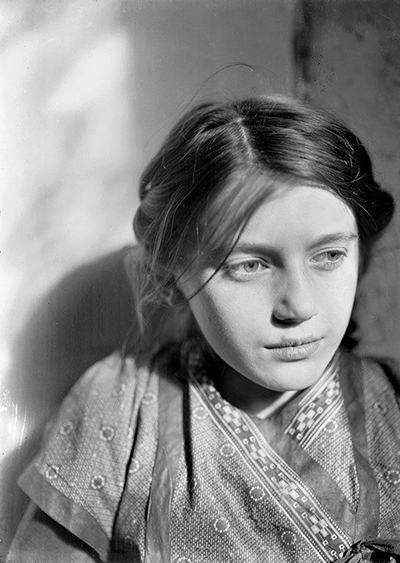Ernst Ludwig Kirchner was the only member of the Expressionist movement to have developed a great passion for photography, whilst some others made only a fleeting use of this art form. In recent years there has been a growing interest in the photography of Kirchner.
Kirchner captured a diverse range of themes within his photographic work, including nude work, scenes from within his own studio plus, of course, portraits and landscapes. He was an experimental artist by nature but particularly so within this medium. He saw so many new possibilities within photography that remained relatively untapped, as opposed to oil painting, watercolour painting and drawing which had developed over many centuries. The portrait photograph that we display here is from 1910 and is of Franzi Fehrman.
There has been a huge collection of negatives uncovered from Kirchner's career, numbering in the thousands. Some of these have been processed into prints in order to put together various exhibitions and these have all proven palatable with a modern art audience that now considers photography to be a highly significant art form. The artist also used photography to document his other artworks, such as recording the display of his paintings within exhibitions for future reference. Whilst this artist remains best known for his paintings, there has been a growing acceptance of his role in the development of German photography.
Art history has a long tradition of creative people who have experimented throughout their careers with a variety of mediums, genres and techniques. Many have found that constant experimentation has been the key to retaining motivation and intrigue, as well as developing onwards as an artist. Work in one area can also impact another just as an artist might study another's work in order to benefit their own careers. There is generally a lot of principles which cross over from one medium to the next. Those more knowledgeable around photography will be aware of the factors that make up a composition such as how the piece is cropped as well as lighting and colour. The rise in prominence of photography brought about the same considerations around cropping in painting, although this was also influenced by styles already found in Japanese art. Kirchner was someone who took his knowledge about the techniques of Expressionist painting into his photography and then back in the opposite direction.
The best place to go in order to learn more about Kirchner photographs would certainly be the museum set up in his name in Davos, Switzerland. They hold around 1500 items in total, which covers a variety of categories including original negatives as well as some prints from various periods. It is relatively rare for even the most famous artists to have museum set up specifically for them, as most artworks are spread across national and local galleries which prefer to cover a good range of different artists and styles in order to make their display as comprehensive and appealing as possible. It is also unusual for any institution to own that many items from a single artist's career, but this situation normally occurs from when the artist themselves bequething a large amount of items all together. Other examples of that in action would be Turner, who donated a huge number of items to the British state, as well as Edvard Munch who did much the same in Norway. Finally, Auguste Rodin's house was converted into a display of the works that he himself left behind, some of which were also photographs.
The local Davos community hold Kirchner in extremely high regard and so efforts have been made to document all of the many items that they have in their possession, ultimately culminating in the construction of the museum in his name. There were also considerable efforts in order to protect all of these items and make very high quality reproductions of them in order to preserve the collection for future generations. One of the ambitions of the museum was to illustrate the variety of Kirchner's oeuvre, which most remain completely unaware of. The mainstream media tend to focus only on the key highlights of an artist's career, just as exhibitions traditionally have done, but those who are particularly familiar with Ernst Ludwig Kirchner will have come across these alternative mediums before. The completed museum has also encouraged a greater mount of tourism within Davos and the larger local area, as this is an artist who now enjoys a truly global reputation.
Photography has been used by artists as both an art form in its own right, but also as a supporting element to other mediums. Rodin for example would photograph his models within his studio in order to refer to them at a later date. He also was able to recall past exhibitions by photographing his sculptures out on display. He also drew and painted over photographs from time to time in order to try out a particular idea and would do the same with his drawings as well. In the early 20th century photography was still very much a new and exciting area that offered huge potential to artists that had yet to be fully tapped into, and Kirchner himself clearly understood this. One can see within the selection of photographs that he left behind that he understood this discipline well and experimented with some of its opportunities carefully, such as with wide angle lenses and close-ups.




